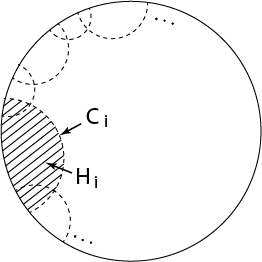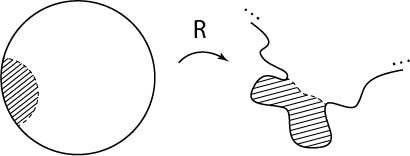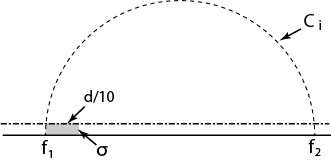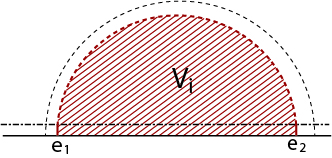Hi guys~ The school year here at Princeton is finally (gradually) starting. So I’m back to this blog :-P
In this past week before anything has started, Assaf Naor came here and gave a couple rather interesting talks, which I decided to make a note about. For the complete content of the talk please refer to this paper by Naor and Mendel. As usual, I make no attempt on covering what was written on the paper nor what was presented in the talk, just some random pieces and bits which I found interesting.
A long time ago, Grothendieck conjectured what is now known as Dvoretzky’s theorem:
Theorem: For any , for any
, there exists
depending only on
such that any normed vector space of dimension
or larger has a k-dimensional linear subspace that embeds (via a linear transformation) with distorsion at most
into the Hilbert space.
i.e. this says in the case where is close to
(let’s write
) for any given k, *any* norm on a vector space of sufficiently high dimension will have a
dimensional subspace that looks almost Eculidean (meaning unit ball is round up to a multiple
).
Well, that’s pretty cool, but linear. As we all know, general metric spaces can be much worse than normed vector spaces. So here comes a nonlinear version of the above, posted by Terrence Tao:
Nonlinear Dvoretzky problem: Given , does there exist a
so that every metric space of Hausdorff dimension
has a subset
of Hausdorff dimension
that embeds into the Hilbert space with distorsion
?
Indeed, we should expect this to be a lot more general and much harder than the linear version, since we know literally nothing about the space except for having large Hausdorff dimension and as we know metric spaces can be pretty bizarre. That why we should find the this new result of theirs amazing:
Theorem 1 (Mendel-Naor): There is a constant such that for any
, every compact metric space with dimension
has a closed subset
of dimension at least
that admits an embedding into Hilbert space with distorsion
.
Note that, in the original linear problem, of course blows up to infinity whenever
or
. (whenever we need a huge dimensional space with fixed ‘flatness’ or a fixed dimension but ‘super-flat’ subspace). That is, when we are looking for subspaces inside a random space with fixed (large) dimension
, the larger dimension we need, the less flat (more distorsion) we can expect it to be. i.e.
necessarily forces
and
forces
.
We can see that this nonlinear theorem is great when we need large dimensional subspaces (when is close to
), but not so great when we want small distorsion (it does not apply when distorsion is smaller than
, and blows up when it gets close to
).
In the original statement of the problem this gives not only that a large exists, but
! In fact, when we are allowing relatively large distorsion (compare to constant
) this theorem is sharp:
Theorem 2 (Mendel-Naor): There exists constant and a family of metric spaces
such that for any small
, no subset of
with dimension
embeds into Hilbert space with distorsion
.
This construction makes use of our all-time favorite: expander graphs! (see pervious post for definitions)
So what if is small? Turns out, unlike in the linear case when
, there is no
, in the paper they also produced spaces
for each
where the only subset that embeds with distorsion <
are of Hausdorff dimension 0!
In his words, the proof of theorem 1 (i.e. the paper) takes five hours to explain, hence I will not do that. But among many neat things appeared in the proof, instead of embedding into the Hilbert space directly they embedded it into an ultrametric space with distorsion , and then make use of the fact that any such space sits in the Hilbert space isometrically.
Definition: An ultrametric on space is a metric with the additional property that for any three points
, we have the so-called strong triangle inequality, i.e.
If one pause and think a bit, this is a quite weird condition: for example, all triangles in an ultrametric space are isosceles with the two same length edge both longer than the third edge; every point is the center of the ball, etc.
Exercise: Come up with an example of an ultrametric that’s not the discrete metric, on an infinite space.
Not so easy, hum? My guess: the first one you came up with is the space of all words in 2-element alphabet , with the dictionary metric (two points are distance
apart where
is the first digit they differ), right?
In fact in some sense all ultrametrics look like that. (i.e. they are represented by an infinite tree with weights assigned to vertices, in the above case a 2-regular tree with equal weights on same level) Topologically our is a Cantor set and sits isometrically in
. It’s not hard to see in fact all such space embeds isometrically in
.
I just want to say that this operation of first construct an ultrametric space according to our given metric space, embed, and then embed the ultrametric metric space into the Hilbert space somehow reminds me of when we want to construct a measure satisfying a certain property, we first construct it on a Cantor set, then divide up the space and use the values on parts of the Cantor set for parts of the space…On this vein the whole problem gets translated to producing a tree that gives the ultrametric and work with the tree (by no means simple, though).
Finally, let’s see a cute statement which can be proved by applying this result:
Urbanski’s conjecture: Any compact metric space of Hausdorff dimension > can be mapped surjectively [thanks to Tushar Das for pointing out the typo] onto the unit ball
by a Lipschitz map.
(note strictly larger is important for our theorem to apply…since we need to subtract an ) and hence another cute statement that’s still not known:
Question: Does any compact metric space with positive Hausdorff -dimensional measure maps Lipschitzly onto
?










